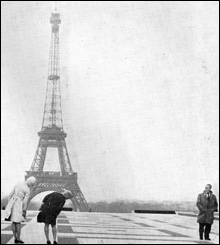
BRIGITTE ET BRIGITTE: Going where The Da Vinci Code doesn’t.
|
Luc Moullet is one of the pioneers of cinema. Although he made his first feature some 70 years after moving photographic images were first projected, and though he is, and had been before he began making films, an accomplished film critic, when he works on a film, it’s as if the cinema had just been invented and he had to figure out what to do with it. The mineral quality of his mise-en-scène, the brusque cutting, yields a presentational kind of cinema in which people, objects, and landscapes seem to have just now sprung into being, for the purposes of the shot.Moullet, whose work is being sampled in a traveling retrospective that is now reaching the Harvard Film Archive, started as a critic for Cahiers du Cinéma, and his well-known essay on American director Samuel Fuller contains clues to his filmmaking direction. He praises “a humor based on ambiguity,” noting that Fuller “pretends to adopt all points of view, and that’s what makes his humor sublime” — a description that could be applied to Moullet’s work, with its pataphysical wit. The modernism of Moullet’s films is already anticipated in this description: “In Fuller we see everything that other directors deliberately excise from their films: disorder, filth, the unexplainable . . . ” And the interest in landscape that will mark Moullet’s movies is heralded in this comment on Fuller’s linking of people to the earth: “Fuller is a primitive, but an intelligent primitive, which is what gives his work such unusual resonances; the spectacle of the physical world, the spectacle of the earth, is his best source of inspiration, and if he is attached to human beings, it is only to the extent that they are themselves attached to the earth.”
It’s no wonder that Moullet called on Fuller to play himself in a short scene in his first feature, BRIGITTE ET BRIGITTE (1966; May 28 at 9 pm). The two heroines, natives of the Alps and the Pyrénées, meet by chance and team up to try life in Paris, where they enroll at the Sorbonne and take crash courses in cinephilia. At once an ironic adventure fable and an anthropological film, Brigitte et Brigitte reveals Moullet as a director of anecdotes, excursions, and spontaneous innovations (the screen going black as one Brigitte dives under the bedcovers). From the start, one of the wellsprings of his work is apparent: an inspiration born of a poverty of means that he uses in order to comment on the absurdity and vanity of his characters’ existence. Much of Brigitte et Brigitte is shot in a studio whose walls have been left undecorated. The exposure of poverty enables Moullet to find, not torpor exactly, but a peculiar tension that comes from the voluntary inadequacy of the fiction to reality and of reality to the fiction.
LES CONTREBANDIÈRES|THE SMUGGLERS (1967; May 28 at 7 pm), a film in praise of smuggling (which by circumventing the war economy helps the cause of peace), is again built on the movement between city and country (here, a cyclical movement) and again involves two women, smugglers who operate under the protection of a male customs officer with whom they set up a ménage à trois. Moullet’s great sense of freedom is communicated to the characters, who, familiar with having “no problems,” find themselves free to try out different cultural experiences.